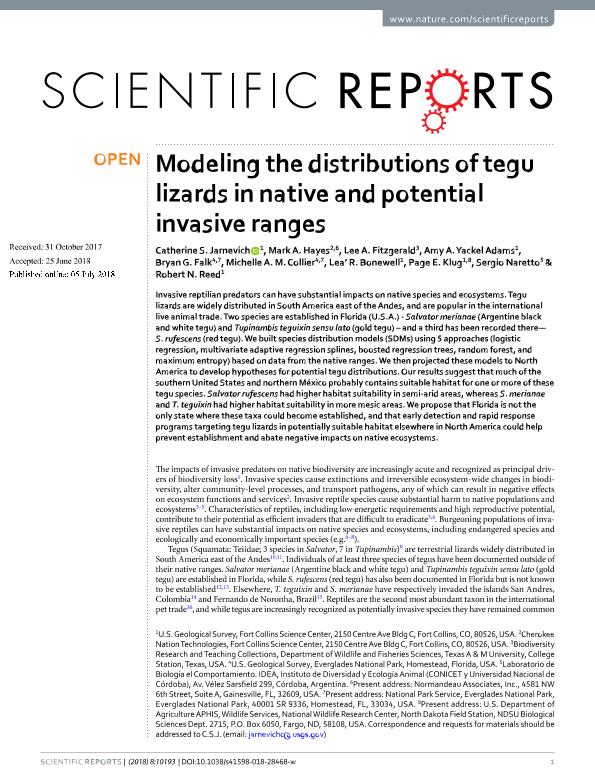Mostrar el registro sencillo del ítem
dc.contributor.author
Jarnevich, Catherine S.
dc.contributor.author
Hayes, Mark A.
dc.contributor.author
Fitzgerald, Lee A.
dc.contributor.author
Yackel Adams, Amy A.
dc.contributor.author
Falk, Bryan G.
dc.contributor.author
Collier, Michelle A. M.
dc.contributor.author
Bonewell, Lea` R.
dc.contributor.author
Klug, Page E.
dc.contributor.author
Naretto, Sergio

dc.contributor.author
Reed, Robert N.
dc.date.available
2019-11-27T17:35:58Z
dc.date.issued
2018-12-05
dc.identifier.citation
Jarnevich, Catherine S.; Hayes, Mark A.; Fitzgerald, Lee A.; Yackel Adams, Amy A.; Falk, Bryan G.; et al.; Modeling the distributions of tegu lizards in native and potential invasive ranges; Nature Publishing Group; Scientific Reports; 8; 1; 5-12-2018
dc.identifier.issn
2045-2322
dc.identifier.uri
http://hdl.handle.net/11336/90664
dc.description.abstract
Invasive reptilian predators can have substantial impacts on native species and ecosystems. Tegu lizards are widely distributed in South America east of the Andes, and are popular in the international live animal trade. Two species are established in Florida (U.S.A.)-Salvator merianae (Argentine black and white tegu) and Tupinambis teguixin sensu lato (gold tegu)-and a third has been recorded there-S. rufescens (red tegu). We built species distribution models (SDMs) using 5 approaches (logistic regression, multivariate adaptive regression splines, boosted regression trees, random forest, and maximum entropy) based on data from the native ranges. We then projected these models to North America to develop hypotheses for potential tegu distributions. Our results suggest that much of the southern United States and northern México probably contains suitable habitat for one or more of these tegu species. Salvator rufescens had higher habitat suitability in semi-arid areas, whereas S. merianae and T. teguixin had higher habitat suitability in more mesic areas. We propose that Florida is not the only state where these taxa could become established, and that early detection and rapid response programs targeting tegu lizards in potentially suitable habitat elsewhere in North America could help prevent establishment and abate negative impacts on native ecosystems.
dc.format
application/pdf
dc.language.iso
eng
dc.publisher
Nature Publishing Group
dc.rights
info:eu-repo/semantics/openAccess
dc.rights.uri
https://creativecommons.org/licenses/by-nc-sa/2.5/ar/
dc.subject
TEGU
dc.subject
Invasive
dc.subject
Lizards
dc.subject
Distributions
dc.subject
Native
dc.subject.classification
Conservación de la Biodiversidad

dc.subject.classification
Ciencias Biológicas

dc.subject.classification
CIENCIAS NATURALES Y EXACTAS

dc.subject.classification
Ecología

dc.subject.classification
Ciencias Biológicas

dc.subject.classification
CIENCIAS NATURALES Y EXACTAS

dc.title
Modeling the distributions of tegu lizards in native and potential invasive ranges
dc.type
info:eu-repo/semantics/article
dc.type
info:ar-repo/semantics/artículo
dc.type
info:eu-repo/semantics/publishedVersion
dc.date.updated
2019-10-16T14:28:31Z
dc.journal.volume
8
dc.journal.number
1
dc.journal.pais
Reino Unido

dc.description.fil
Fil: Jarnevich, Catherine S.. U.s. Geological Survey; Estados Unidos
dc.description.fil
Fil: Hayes, Mark A.. Cherokee Nation Technologies; Estados Unidos
dc.description.fil
Fil: Fitzgerald, Lee A.. Department Of Wildlife And Fisheries Sciences; Estados Unidos
dc.description.fil
Fil: Yackel Adams, Amy A.. U.s. Geological Survey; Estados Unidos
dc.description.fil
Fil: Falk, Bryan G.. U.s. Geological Survey; Estados Unidos. National Park Service; Estados Unidos
dc.description.fil
Fil: Collier, Michelle A. M.. National Park Service; Estados Unidos. U.s. Geological Survey; Estados Unidos
dc.description.fil
Fil: Bonewell, Lea` R.. U.s. Geological Survey; Estados Unidos
dc.description.fil
Fil: Klug, Page E.. U.s. Geological Survey; Estados Unidos. U.S. Department of Agriculture APHIS, Wildlife Services, National Wildlife Research Center, North Dakota Field Station; Estados Unidos
dc.description.fil
Fil: Naretto, Sergio. Consejo Nacional de Investigaciones Científicas y Técnicas. Centro Científico Tecnológico Conicet - Córdoba. Instituto de Diversidad y Ecología Animal. Universidad Nacional de Córdoba. Facultad de Ciencias Exactas Físicas y Naturales. Instituto de Diversidad y Ecología Animal; Argentina
dc.description.fil
Fil: Reed, Robert N.. U.s. Geological Survey; Estados Unidos
dc.journal.title
Scientific Reports
dc.relation.alternativeid
info:eu-repo/semantics/altIdentifier/url/http://www.nature.com/articles/s41598-018-28468-w
dc.relation.alternativeid
info:eu-repo/semantics/altIdentifier/doi/http://dx.doi.org/10.1038/s41598-018-28468-w
Archivos asociados
